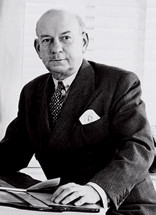Walter Dorwin Teague
| Walter Dorwin Teague | |
|---|---|
 |
|
| Born | December 18, 1883 Pendleton, Indiana |
| Died | December 5, 1960 (aged 76) Flemington, New Jersey |
| Nationality | United States |
| Alma mater | Art Students League of New York |
| Occupation | Architect |
| Spouse(s) | Celia Fehon |
| Projects | New York World's Fair Kodak products Steinway piano |
Walter Dorwin Teague (December 18, 1883 - December 5, 1960) was an American industrial designer, architect, illustrator, graphic designer, writer, and entrepreneur. Often referred to as the "Dean of Industrial Design", Teague pioneered in the establishment of industrial design as a profession in the US, along with Norman Bel Geddes, Raymond Loewy, and Henry Dreyfuss.
Regarded as a classicist and a traditionalist despite a later shift to modern tastes, Teague is recognized as a critical figure in the spread of mid-century modernism in America. He is widely known for his exhibition designs during the 1939-40 New York World's Fair, such as the Ford Building, and his iconic product and package designs, from Eastman Kodak's Bantam Special to the steel-legged Steinway piano.
A self-described late starter whose professional acclaim began as he approached age 50, Teague sought to create heirlooms out of mass-produced manufactured objects, and frequently cited beauty as "visible rightness". In 1926, Teague assembled an industrial design consultancy (now known as Teague), which carries on his legacy today, in name and vision.
Teague was one of six children born to an established Decatur, Indiana family. In 1840, Teague's grandfather had moved from North Carolina to Pendleton, Indiana, home to one of America's largest Quaker communities. Teague's father, of Irish forebears, became a circuit-riding Methodist minister (and later full-time tailor) who settled in Pendleton with his family. With little money, the Teague household was laden with books.
At age 16, while he was still in school in Pendleton, Teague worked as a handyman at the local paper, where he quickly became a jack-of-all-trades and eventually a reporter.
Books on architecture in his high school library influenced Teague's desire to become an artist. At 19 years old, Teague left Indiana for New York City. He studied painting from 1903 to 1907 at the Art Students League of New York, where he met his first wife, Celia Fehon, a fellow artist. To earn money upon his arrival in New York, Teague checked hats at the Young Men's Christian Association in Manhattan, where he also began sign painting. His lettering work evolved into illustration projects for mail order catalogues, for which he drew apparel items such as neckties and shoes. Refusing involvement in the fashion industry, Teague focused his creative efforts on elaborate advertising illustrations, which caught the attention of Walter Whitehead, an advertising executive whom Teague had met at the YMCA.
...
Wikipedia
